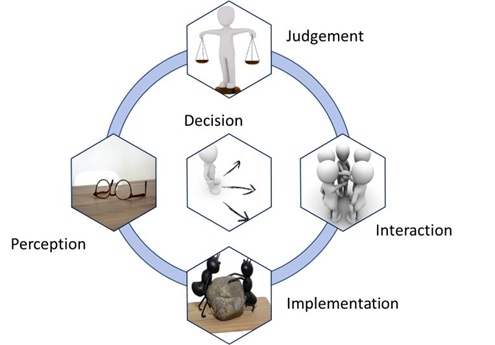What unconscious biases are and what they cause - a definition
The term "bias" is sometimes used in different contexts, as it can denote a wide variety of phenomena (details on meanings and definitions).
It is therefore important to use a definition of unconscious biases that is practically relevant and applicable.
Unconscious biases - a definition for practical application
Biases can be described by the following characteristics, they are:
- an erroneous,
- systematic deviation,
- are based on cognitive heuristics,
- usually remain unconscious, and
- are predictable to a certain degree.
Biases lead to a result that is called irrational. The concept of irrationality is not about an objectively correct view of the world. The systematic deviation leads to a result that is not in the interest of the respective person or their environment, but is detrimental. In the absence of the bias, this negative effect would not be present and the action would therefore be rational.
Cognitive heuristics, also known as thought patterns, are a central element for people and are dealt with in more detail in the background to biases.
What does the unconscious bias definition mean in practice?
The practical consequence of biases is a negative effect on the respective person or their environment, such as their family or work environment. The person is usually not aware of the bias and believes to act objectively and rationally in the specific situation.
This phenomenon is called bias blind spot - the failure to recognise one's own relevant biases. As a result, the self-assessment also deviates from the real existing situation.
Unconscious biases can be seen as a consequence of the extremely fast functioning of our brain, which has proven itself in evolution - however, we act less rationally than we believe ourselves to be!
Another effect of Unconscious Biases can arise because of the predictability of some effects. One person's knowledge of another's unconscious biases can be used to one's own advantage - the desired behaviour, which is disadvantageous for the person performing it, is "triggered", i.e. deliberately triggered.

Bias - the different meanings and definitions
The term can be used in different contexts, hence can have alternative meanings..
- In the field of technology, it refers to a constant, one-sided variable (such as electric current or voltage) or a bias of tape material due to the superimposition of a high-frequency signal during recording.
- Likewise, a distortion, a measurement deviation or a systematic error in the field of technology or mathematics is called a bias. Here a connection to the field of psychology arises.
- Bias in the context of human action is used in different ways and denotes, for example:
- One-sidedness
- Partiality
- Tendency or inclination
- Subjectivity
- Preference
- Prejudice
- Cognitive distortion
When hearing the term bias, it is therefore important to consider the context as well as the background of the person using it. They reflect a wide variety of meanings.
Overview of unconscious biases
With the help of a quick internet search, for example on Wikipedia, the number of unconscious biases can be quickly determined. There are about 200 different types of unconscious biases.
For a better overview, various attempts have been made to classify them into categories. These classifications are usually taken from psychological theory or are assigned to very specific fields of application (e.g. very often diversity & inclusion).
These classifications offer good overviews in the case of already existing specialist knowledge or reduced content-related interests. However, they do not satisfy
- from a practical point of view, especially from a company perspective and
- to appreciate the wide range of applications of Unconscious Biases.
A practical, new system of unconscious biases
Mind your business has developed an independent system of Unconscious Biases. This allows to:
- allocate the various biases to practical activities,
- correlate concrete cases (in private or in business) and
- build effective countermeasures on them.
Unconscious biases affect the following five areas:
- Perception - how do we interpret information from our environment, through which glasses do we see the world?
- Judgement - how do we arrive at opinions, judgements and priorities?
- Decision - how do we choose one option out of several, based on what criteria?
- Interaction - how do we communicate and work together with others and what interactions result from this?
- Implementation - how do we implement the decisions we have made and assess the success of these decisions?
It is also important to consider the interactions between these areas. For example, a decision-making process in a management meeting is influenced by various biases, and the focus is on decision-making and interaction.
The essential advantage of this approach becomes apparent in the discussion with people from practice and in the transfer of concrete improvement measures. Mind your business is based on long-term, practical questions and their solutions - in comparison, psychological, theoretical methods offer fewer starting points for a successful transfer.

The application of the five areas
The practice-based structure is the basis of the various workshops and webinars.
It is also applied in the various stages of de-biasing, where it is about concrete measures against the negative effects of biases.
The impact of unconscious biases
Biases and thinking errors have an impact on a personal level, interpersonally and in teams and organisations. The approximately 200 different biases have an impact in all five areas, depending on their nature and expression.
Example personal area:
- Perception: I am only selectively aware of information on an important political issue.
- Judgement: I overestimate my abilities in my favourite sport and injure myself.
- Decision: I regularly participate in gambling because I overestimate my chances of winning.
- Interaction: I am persuaded to buy an overpriced property.
- Implementation: I explain afterwards why it was necessary for me to change jobs.
Unconscious biases have negative effects on all of us. They are not limited to the personal level - biases in companies lead to performing worse than the competition and, in the worst case, endanger the existence of the organisation.
Stereotypes, prejudices and discrimination are also based on various biases.
It therefore pays to deal with unconscious biases on different levels and to develop countermeasures - this is what we call de-biasing.
What are the backgrounds of biases? The better we understand them, the more effective we can act against them.
Stereotypes and prejudices
Biases are closely linked to the formation of stereotypes, especially from the categories of perception and judgement.
Stereotypes are simplified, memorable and often pictorial descriptions of people or groups. Certain characteristics or behaviours are attributed to them. The process of quick categorisation, for example, on the basis of external appearance, is automatic and fast; biases can have a corresponding effect here or be reinforced, since existing stereotypes can influence elements such as perception or judgement.
Compared to stereotypes, prejudices are loaded with emotions, positive or negative. Stereotypes are the practical preliminary stage - when they are believed and have an affective effect, we speak of prejudices. The connection to biases is a circular one - prejudices can reinforce biases (for instance relevant in confirmation bias), biases can further consolidate prejudices.

Are biases only negative?
This question has often been asked in workshops or webinars - are biases always only negative?
The answer is - biases have negative effects according to the common definitions. However, this does not mean that we have to be bad people as a result.
Unconscious biases are a side effect of mechanisms that have made us evolutionarily successful as a human race. Our brain's autopilot guides us through life largely error-free; our brain is an impressive organ.
We cannot deny that Unconscious Biases are present and deeply ingrained - this has been scientifically researched and sufficiently proven over decades.
The bottom line:
- We are human beings - we have biases.
- Let's accept this fact and not forget it:
We have the possibilities to reduce the negative effects through de-biasing!
